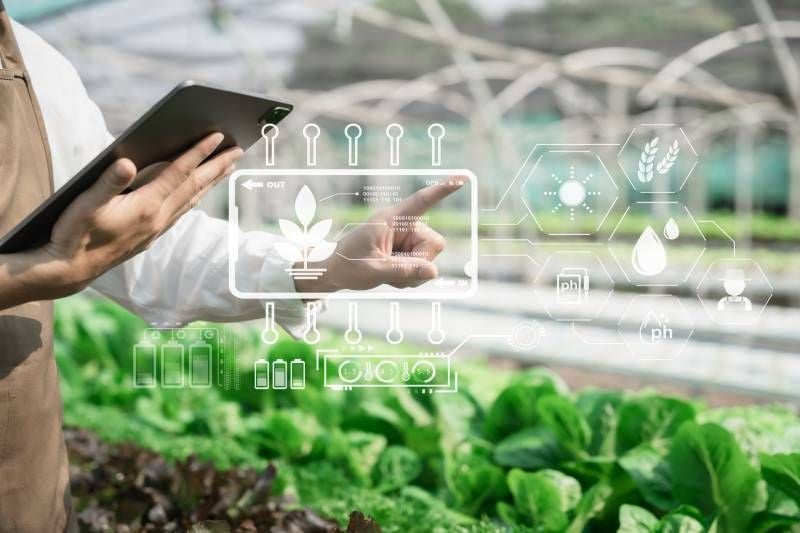A Comparison of Soil-Based and Hydroponic Commercial Greenhouse Systems
)
Commercial greenhouse systems are essential to modern agriculture because they help to meet the growing demand for fresh produce while reducing the effects of climate change and the scarcity of arable land. Two prominent methodologies employed in these systems are hydroponic and soil-based cultivation. Every technique has its own set of benefits and drawbacks that influence the commercial greenhouse farming environment.
Understanding Hydroponic Systems
In hydroponic greenhouse systems, plants are grown without soil in a nutrient-rich water solution. Plants obtain vital nutrients directly through water, which is carefully controlled to maintain ideal growing conditions, as opposed to relying on soil for nutrient absorption. This approach has a number of benefits:
Water Efficiency: Because water is recycled within the closed system, hydroponic systems usually consume a great deal less water than traditional soil-based farming.
Space Optimization: Vertical design of hydroponic systems allows for optimal use of available space. This is especially helpful in cities or other places where there is a shortage of available land.
Enhanced Nutrient Absorption: Plants grown in hydroponic systems are able to absorb nutrients more effectively since they are easily accessible in the water solution. This could result in faster development and larger harvests.
Decreased Risk of Soil-Borne Diseases: Hydroponic systems have a lower susceptibility to soil-borne infections and diseases because they don't grow plants in soil, which means they require fewer chemical pesticides and fungicides.
Hydroponic systems do, however, come with several drawbacks, such as:
Initial Investment: Pumps, nutrient solutions, and monitoring equipment are just a few of the foundational items that may need to be purchased in order to set up a hydroponic greenhouse system.
Technical know-how: Maintaining a hydroponic system calls for a certain degree of know-how in pH balancing, nutrient management, and water quality monitoring.
Dependency on Electricity: Hydroponic systems frequently use electricity to run lighting, pumps, and climate control systems, which raises operating expenses and has an adverse effect on the environment.
Exploring Soil-Based Systems
Conversely, soil-based greenhouse systems depend on conventional soil cultivation techniques, in which plants are cultivated in the greenhouse's soil beds or containers. Since it has been used for centuries, soil-based agriculture provides a number of advantages.
Natural Nutrient supply: Soil is a comprehensive supply of nutrients for crops since it naturally includes a wide variety of nutrients that are necessary for plant growth.
Lower Initial Investment: Since soil-based greenhouses rely on conventional agricultural methods and tools, they may be less expensive to start up than hydroponic systems.
Environmental Resilience: Because plants have access to a natural substrate for nutrient absorption, soil-based systems are frequently more resilient to changes in environmental conditions, such as power outages or equipment failures.
Enhanced Nutrient Diversity: The organic matter and microorganisms found in soil support plant nutrition and soil health, which may improve crop flavour and nutritional content.
But soil-based systems have drawbacks as well
Limited Space Utilization: The potential for vertical farming and maximizing land use may be limited by the fact that soil-based growing may not maximize space as effectively as hydroponic systems.
Water Management Challenges: Plant health is impacted by root rot and waterlogging, which can be caused by overwatering or improper drainage of the soil.
Degradation of the Soil: Over time, intensive farming methods may cause soil erosion and degradation, which may have an effect on the long-term viability of agriculture.
Finding the Right Balance
Both soil-based and hydroponic commercial greenhouse systems have unique benefits and difficulties. The decision between the two is influenced by a number of variables, such as crop type, market demand, environmental factors, and resource availability. While some growers may favour soil-based production due to its natural nutrition source and environmental resilience, others may choose hydroponic systems to enhance water efficiency and space utilization in urban contexts.
In order to ensure sustainable food production for future generations, commercial greenhouse farming ultimately demands striking a balance between technological innovation and traditional farming practices. In a fast changing agricultural world, growers may maximize crop yields, reduce environmental impact, and meet changing consumer demands by carefully weighing the benefits and drawbacks of hydroponic and soil-based systems.
For more soil-based and hydroponic commercial greenhouse systems tips, contact the Cultivate & Equipment team today! Our team would love to set up a free consultation or provide more information about any of our greenhouse growing systems, products, or services.
| Tags:GreenhouseLatest News |

